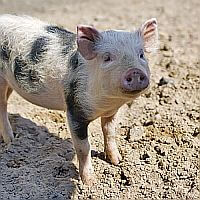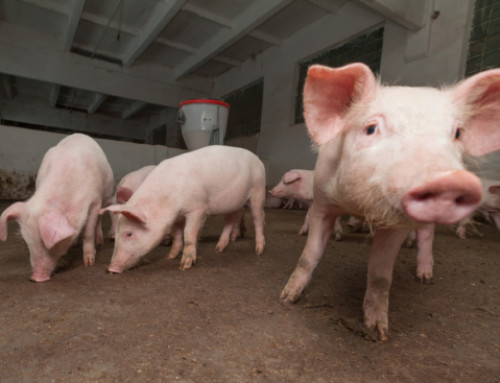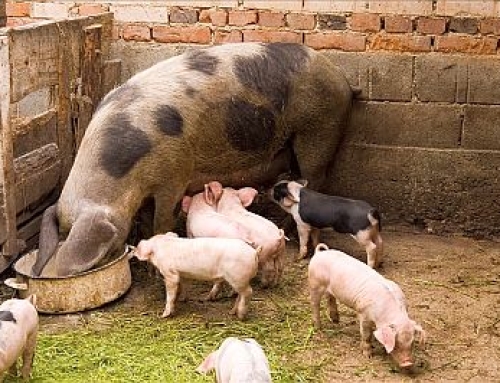There are many viral diseases that can hit pigs. The severity of their effect varies from country to country, from farm to farm. However, knowing what each disease looks like when it affects your pigs may help you contain them to reduce the losses that it would have caused.
Foot-and-Mouth Disease (FMD)
Foot-and-mouth disease would show in how pigs suddenly reduce their food consumption and how they would look depressed. It also comes with fevers reaching about 40.5º C. 
The disease can be transmitted through direct and indirect contact with infected pigs. The virus can spread by saliva, aerosol, blood, nasal discharge, feces, urine, semen, meat or bones of the infected animals, and infected animal by-products.
FMD cannot be treated, so the affected pigs should be destroyed. This can be prevented by routine vaccination, although this will only last for six months. Farmers should be cautious of the symptoms to prevent the spread before it gets worse.
FMD is highly infectious and can spread rapidly throughout the population of animals, even reaching long distances, depending on the wind. This makes it harder and more costly to control.
African Swine Fever
This often affects domestic pigs. Its common symptoms include blotching of skin, fever, and the hemorrhaging of internal organs, lymph nodes, and gastrointestinal tract.
The virus can spread through direct contact with the infected pigs and fomites, tick bites, ingestion of contaminated uncooked pig by-products, and contact with wild carrier and domestic pigs. The carcass of the affected animals is condemned.
The carcass of the affected animals is condemned.
All of the herd hit by ASF would become ill and most of them would die. There is no treatment available, which is why some countries infected by the ASF often resort to a slaughter policy to completely eradicate the virus and contain its spread. Affected animals should be kept away from the unexposed animals as a preventive measure.
Porcine Epidemic Diarrhea (PED)
This is a highly contagious viral disease among pigs, which has recently affected virus states in the US. It was first diagnosed in the country in May 2013. This causes severe diarrhea and dehydration among pigs.
of animals, even reaching long distances, depending on the wind. This makes it harder and more costly to control.
African Swine Fever
This often affects domestic pigs. Its common symptoms include blotching of skin, fever, and the hemorrhaging of internal organs, lymph nodes, and gastrointestinal tract.
The virus can spread through direct contact with the infected pigs and fomites, tick bites, ingestion of contaminated uncooked pig by-products, and contact with wild carrier and domestic pigs. The carcass of the affected animals is condemned.
All of the herd hit by ASF would become ill and most of them would die. There is no treatment available, which is why some countries infected by the ASF often resort to a slaughter policy to completely eradicate the virus and contain its spread. Affected animals should be kept away from the unexposed animals as a preventive measure.
Porcine Epidemic Diarrhea (PED)
This is a highly contagious viral disease among pigs, which has recently affected virus states in the US. It was first diagnosed in the country in May 2013. This causes severe diarrhea and dehydration among pigs.
The PED virus is a coronavirus that affects the cells of the small intestine’s lining in pigs, leading to porcine epidemic diarrhea. Adult hogs usually get sick and lose weight, while piglets often die within five days of being infected by the virus.
As of now, no specific treatment is available. There are general preventive measures, though. Infected pigs should be given clean water, while finishing pigs should not be fed for one to two days. Since the PED virus can be spread by animals, people, and fomites, extreme care should be taken to protect the unexposed pigs.
PED has killed around 4 to 5 million hogs in the US since 2013. Since it has affected North Carolina, the second biggest producer of hogs in the US, it is now considered an economic problem.
It helps to improve the hog farms’ safety practices. Everyone must be extra cautious, even in the smallest things, such as the cleanliness of the workers’ footwear. Disinfecting equipment, for instance, must be taken seriously. These may help control the virus because it spreads through the feces of the infected swine, or contaminated boots, equipment, hands, and clothing. However, many hog farmers say that even these may not have an instant significant effect on the spread of the pig viruses now.
Porcine Parvovirus Infection (PPV)
PPV is occurring and common worldwide. It is probably the biggest factor that leads to infectious infertility. It usually breeds in the intestine of the pig and does not show any symptoms. The bad news is that it can even survive despite living outside the host for months and is resistant to many disinfectants, which is possibly why it spreads fast and is hard to control.
PPV may infect healthy animals via contact with infected animals, fomites, embryos or semen.
Herds that are free of PPV must be protected against the infected pigs. Newly bought animals should be separated from the others for three weeks to ensure that they are not infected. Pregnant pigs are not ideal investments either because they could spread the endemic virus. Tighter fomites control and farm perimeter security are key preventive measures too.
There are some live and inactivated vaccines that may prevent PPV, one of which can be used on pigs that are five months or older for two initial doses to protect them for two years. Boars and sows should be vaccinated.
Teschen/Talfan Disease
Teschen disease is triggered by a porcine enterovirus, serotype 1. It infects pigs worldwide, although outbreaks are rare. The last major outbreaks happened many years ago around the borders of Poland and Germany, as well as in Madagascar. Since then, there have been only milder and smaller outbreaks, called Talfan disease.
The most common symptoms include your pigs losing some of their lower back legs, thighs, and their rear end, with worse cases causing paralysis.
despite living outside the host for months and is resistant to many disinfectants, which is possibly why it spreads fast and is hard to control.
PPV may infect healthy animals via contact with infected animals, fomites, embryos or semen.
Herds that are free of PPV must be protected against the infected pigs. Newly bought animals should be separated from the others for three weeks to ensure that they are not infected. Pregnant pigs are not ideal investments either because they could spread the endemic virus. Tighter fomites control and farm perimeter security are key preventive measures too.
There are some live and inactivated vaccines that may prevent PPV, one of which can be used on pigs that are five months or older for two initial doses to protect them for two years. Boars and sows should be vaccinated.
Teschen/Talfan Disease
Teschen disease is triggered by a porcine enterovirus, serotype 1. It infects pigs worldwide, although outbreaks are rare. The last major outbreaks happened many years ago around the borders of Poland and Germany, as well as in Madagascar. Since then, there have been only milder and smaller outbreaks, called Talfan disease.
The most common symptoms include your pigs losing some of their lower back legs, thighs, and their rear end, with worse cases causing paralysis. The affected pigs may eat less and seem a little depressed for a day, but will behave normally the next day. They would have difficulty rising from a dog-sitting position and can barely walk.
The disease is often caused by poor hygiene, or the contamination of pig pens through the brushes, boots, shovels and clothing, equipment and feces, and the workers’ clothing and boots.
So far, Teschen disease has no effective treatment. There are inactivated or attenuated vaccines that can be used, but none that is commercially available because of how uncommon the disease is. As a preventive measure, piglets have to drink enough colostrum. Extreme care must be taken if you don’t want your infected herd to be slaughtered right away.
Swine Vesicular Disease
Swine vesicular disease is a viral disease that had its first outbreak in 1966 in Italy and in 1972 in Great Britain. It continues to haunt Italy hog farmers, although the rest of Europe is still safe from the disease.
Its most common symptoms include loss of appetite, fever, blisters on the snout, lips, and tongue, and lameness caused by the blisters on their toes and hooves erupting. Severe blistering often leads to the shedding of the hoof head.
Vaccination, however, is not recommended by the World Organisation for Animal Health, because it could mask the disease and prevent it from being diagnosed.
But the main precautionary measures taken by the industry include carefully monitoring the importation of pigs and related meat products from countries known to have SVD. These products pose a high risk of spreading the disease because the SVD virus can survive even during the death of the pigs.
Pigs that are tested positive for the disease are instantly slaughtered, as well as those that have come in contact with such pigs. The biggest danger though, would come from the pig lorries that have come from Italy, where SVD is still rampant among local pigs. Since SVD is not airborne, you can use the precautions previously designed to help control the disease.
References:
The Pig Site, Viruses
The Pig Site, foot and Mouth Disease
The Pig Site, African Swine Fever
The Pig Site, Porcine Epidemic Diarrhea
The Pig Site, Porcine Parvovirus Infection (PPV)
PORCINE PARVOVIRUS
Prevent Spread of Porcine Epidemic Diarrhea
The Pig Site, Teschen Disease
The Pig Site, Swine vesicular disease







Leave A Comment